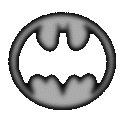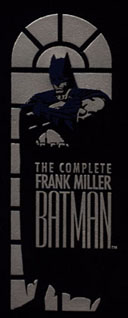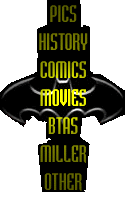






Batman: Variations on a
Dark Knight
Frank Miller's Batman Universe
"Wait a second," you might be saying to yourself. "Why does this otherwise infallible site have a 'Comics' section and a "Frank Miller' section?"
The answer is simple, and almost certainly apparent to anyone who is familiar with Frank Miller's interpretation of the Batman mythos.
In 1984, DC Comics published a series of comics by Frank Miller, entitled The Dark Knight Returns. Pondering what would happen to Batman in his later years, Miller's proposed that Bruce Wayne had retired as Batman in his forties, only to return to service as the Dark Knight some ten years later, when a viscous gang of mutants overtakes Gotham City. Although the main storyline and plot points of the traditional Batman universe are intact, there are several variations on the theme that make this Batman unique to Frank Miller's style.
But what makes Frank Miller's interpretation so noteworthy(?) (and more importantly, worthy of its own section on this cool website?) The answer might simply be lowered to a degree of my own personal taste, but I think that it's much more than that. If you read some of the articles to the right (namely "The Mark of Batman" by Alan Moore and "Notes by Frank Miller" by guess who) the main point that comes across is that the general public's perception of Batman was of Adam West and Burt Ward in tights. Although that 60's TV show served its purpose in making Batman popular (and in having a hypnotically addictive theme song), it didn't do much in the way of people's perception of the Caped Crusader as a character to be taken seriously.
For the most part, the comics reflected that. Who was D.C. comics to mess the financial success of the campy television series? Making the comics equally campy seemed to be a no-brainer. Later attempts at serious storylines in the Batman comics series were not generally accepted by the masses, with the image of Adam West ingrained in their minds, circled by the ocassional "pow," "biff," or "oof."
What Frank Miller did was take a daring, stupid, yet ultimately ingenious risk with his release of The Dark Knight Returns. Gotham was darker, grittier, and much less hospitable then earlier versions of the city. It's protector, Batman, had a biting, almost acidic edge to him, his darkness showing through as a true "Dark Knight," a chivalrous and heroic character who nonetheless had a darker side within that served to get the job done. Dark Knight took the comics world by storm and was applauded for its successful marriage of a serious comic book story (which most people had considered an oxymoron) and an grandiose story of epic portions for Batman, a character whose image as a silly hero in tights rapidly faded in favor of a more complex, compelling, and modern version of Batman. That is why I hold Frank Miller in such high regard, and why I see his comic, The Dark Knight Returns, as not the return, but the birth of the modern-day Dark Knight.
© 1998 Michael Day. Batman and all related characters and indicia are trademarks of DC Comics, Inc. All rights reserved.
MILLER
Overview
Introduction to The Complete Frank Miller Batman
Wanted:
Santa Claus
-- Dead or Alive


